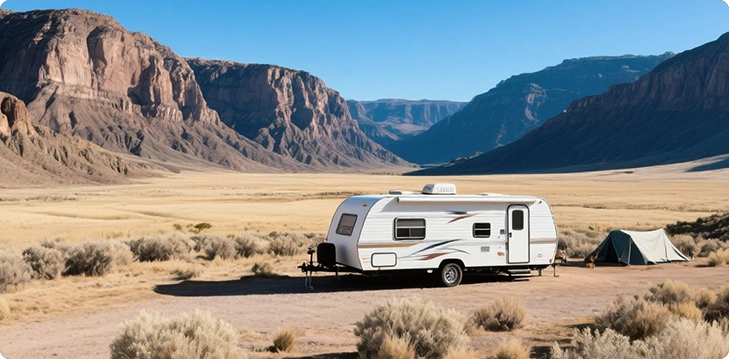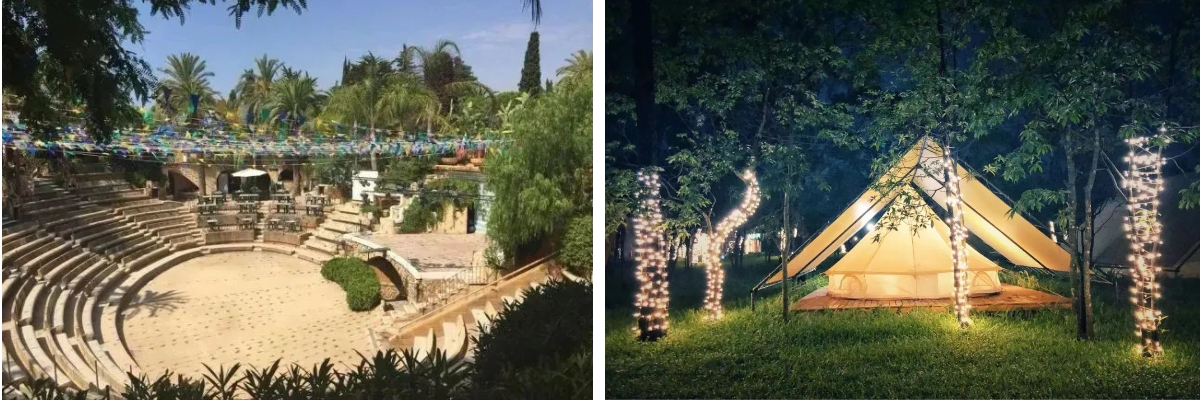Design of Tourism Campsites
1. Site Selection for Tourism Campsites
The site selection of a tourism campsite should mainly satisfy four conditions: environment, transportation, location, and land use. A pleasant environment, convenient transportation, favorable location, and sufficient land are essential for the success of a campsite. However, different types of campsites may prioritize these conditions differently.
Environment: Flat and open terrain with good ventilation and drainage, beautiful ecological surroundings, ideally adjacent to natural or artificial water bodies.
Transportation: Distance from the local central city should be less than 150 km, with a travel time under 2 hours.
Location: Convenient access, preferably near scenic spots or tourist cities.
Land use: Determined according to existing conditions, adapting campsite size and type to local resources.
2. Functional Zoning of Tourism Campsites
Depending on their type, unique features, and target market characteristics, tourism campsites are generally divided into several functional zones, typically including: comprehensive service zone, camping zone, and leisure/entertainment zone.
Some campsites may extend or refine these zones by adding vacation resorts, tourism real estate, or timeshare services based on market demand.
★ Comprehensive Service Zone
Function: Management and service center of the campsite, providing essential services.
Main Services: Reservation, dining, shopping, medical care, rentals, information services, etc.
★ Camping Zone
Function: The main functional area, providing accommodation for campers.
Main Services: Separate RV areas, tent camping areas, trailer areas, and cabin areas.
★ Leisure and Entertainment Zone
Function: Public activity area for recreation and leisure.
Main Services: Fishing, barbecues, fruit picking, rock climbing, grass skiing, sports, and water entertainment activities.
3. Planning of Tourism Campsite Products
The planning of tourism campsites is influenced by natural conditions such as road access, terrain, vegetation, sunlight, and ventilation. In particular, the camping zone requires suitable terrain, slope, and drainage. Campsite planning must also ensure smooth vehicle circulation. Zoning and layout should be designed in harmony with local terrain and natural resources.
Tourism campsite master plans generally adopt three spatial layout models: Uniform Development, Radial, and Central Axis.
★ Uniform Development Model
Characteristics: Management center located in the middle or entrance of the site for convenient overall control. Service facilities (e.g., service center, RV repair) are centrally placed. The camping zone is regularly arranged around the service zone, while entertainment zones are located separately.
Advantages: Efficient land use, easy management, low cost, simple traffic organization, clear road network.
Disadvantages: Landscape is often monotonous and lacks variety.
Suitable Conditions:
Flat, regular-shaped land such as plains, gentle hills, coastal deserts, or grasslands.
Scenic areas with limited land supply where compact layouts and land-saving are essential.
★ Radial Model
Characteristics: Management and service facilities are located at the center or junction of land parcels. Camping zones are irregularly distributed around them according to terrain.
Advantages: Flexible integration of scattered land, adaptable to natural conditions, diverse landscapes, independent camping areas, possibility to integrate entertainment facilities into each zone.
Suitable Conditions:
Forests, riversides, or delta plains with radial land distribution.
Terraced terrain with fragmented but connected land parcels.
Hilly areas with gentle slopes.
Scenic areas with complex topography and dispersed resources requiring protection.
Campsites emphasizing varied and distinctive landscapes.
★ Central Axis Model
Characteristics: A main road runs through the site, with camping and recreation areas arranged along both sides.
Advantages: Independent camping zones, strong adaptability, unique features tailored to environment, flexibility in development.
Disadvantages: Layout is dispersed, management is more difficult, service facilities require duplication across zones, resulting in higher costs.
Suitable Conditions: Large scenic areas with long sightseeing routes or mountainous regions with dispersed attractions.
4. Campsite Layout Design
Tourism campsites consist of varying numbers and sizes of campsites (pitches). Layout options include drive-through, back-in, or side-entry designs, depending on the type of pitch and facilities (e.g., water, power, sewage).
Based on existing campsite designs, four main layout models are identified: Single-Pitch, Multi-Pitch, Transitional, and Mixed.
1) Single-Pitch Model
Each pitch is designed for one vehicle, covering approx. 100–120㎡, including space for tent setup, parking, tables/chairs, and activities.
Each pitch is equipped with independent water, electricity, and sewage outlets.
Natural barriers (plants, ropes, stones, fences, logs) provide separation (12–25 cm distance).
Advantages: Privacy, minimal interference, easy management.
Disadvantages: Higher road and construction costs, less flexible during peak seasons, poor for group activities.
2) Multi-Pitch Model
Designed for groups, arranged around a central plaza.
Flexible spacing during peak seasons, accommodates more vehicles, lower construction costs, suitable for group events.
Disadvantages: Less privacy, more interference among campers, difficult to manage without guidance.
3) Transitional Model
Combines both single-pitch and small-scale multi-pitch (4–6 vehicles) areas.
Advantages: Provides private space while supporting group activities, more balanced and user-friendly.
4) Mixed Model
Single pitches arranged around the periphery, with central communal activity zones.
Facilities similar to single-pitch, but enhanced with shared entertainment or group activity spaces.
Advantages: Offers both privacy and opportunities for group interaction, ideal for family groups.
Disadvantages: Requires larger land area and higher construction costs.
5. Essential Facilities for Tourism Campsites
Campsite facilities can be divided into Pitch Areas, Management Facilities, Sanitary Facilities, and Auxiliary Facilities.
1) Pitch Area
RV pitch size: 80–100㎡, including tent setup, parking, and activity space.
Equipped with water, drainage, power, and communication networks.
Facilities include sinks, dishwashing areas, power outlets, etc.
2) Management Facilities
The management center serves as the operational hub and representative building. Its architectural style should reflect uniqueness.
Should include: reception, offices, clinic, restrooms, lounge, duty room, showers, kitchen/dining hall, storage, and possibly a small shopping area.
Additional elements: security, fences, signage, vehicle/pedestrian paths, broadcasting and telephone systems, waste disposal, parking, and fire safety facilities.
3) Sanitary Facilities
Toilets, showers, washrooms, dishwashing areas (kitchens), laundries, and sewage treatment facilities.
4) Auxiliary Facilities
Shops, restaurants, children’s playgrounds, multi-purpose squares, clubhouses, simple accommodation units, and user-friendly amenities.







